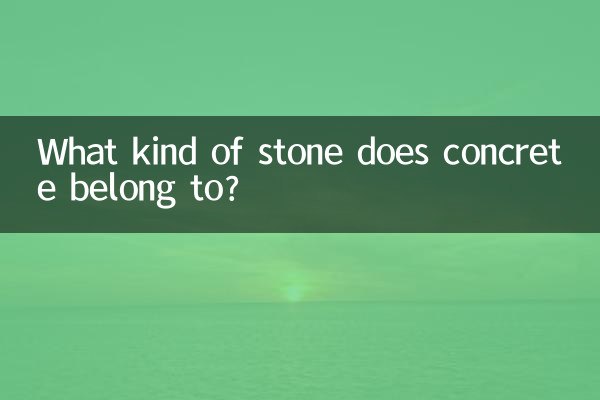What kind of stone does concrete belong to?
Concrete is one of the most common building materials in modern society, but what kind of stone does it belong to? From a scientific perspective, concrete is aartificial stone, made from a variety of natural materials that are mixed, poured and cured. This article will discuss the classification, composition and application of concrete in modern architecture based on the hot topics and hot content on the Internet in the past 10 days.
1. Composition and classification of concrete

The main ingredients of concrete include cement, aggregate (sand, stone), water and additives. According to different proportions and uses, concrete can be divided into the following categories:
| Type | Main ingredients | Purpose |
|---|---|---|
| Ordinary concrete | Cement, sand, gravel | Building foundations and walls |
| lightweight concrete | Cement, lightweight aggregate (such as ceramsite) | thermal insulation layer |
| high strength concrete | High-grade cement and high-quality aggregate | high-rise buildings, bridges |
| fiber concrete | Cement, fiber materials (such as steel fiber) | Crack-resistant and earthquake-resistant structure |
2. The difference between concrete and natural stone
Although concrete is called "artificial stone", it is significantly different from natural stone in its formation process and properties:
| Comparative item | concrete | natural stone |
|---|---|---|
| Formation method | Manual preparation and pouring | natural geological processes |
| Ingredients | Cement, aggregate, additives | Mineral crystals (such as granite, marble) |
| intensity | Adjustable (20-100MPa) | Fixed (depending on stone type) |
| Environmental protection | High production energy consumption and recyclable | Mining destroys ecology and is non-renewable |
3. Recent hot topics: innovative applications of concrete
In the past 10 days, discussions about concrete on the entire Internet have mainly focused on the following aspects:
1.low carbon concrete: With the increasing awareness of environmental protection, researchers are developing low-carbon concrete that uses industrial waste (such as fly ash and slag) to replace part of the cement to reduce carbon emissions.
2.3D printed concrete: The construction industry has begun to try to use 3D printing technology to manufacture concrete structures to save materials and time. This technology has made a breakthrough in small-scale residential construction.
3.self-healing concrete: Scientists add microorganisms or encapsulated repair agents to concrete so that it can automatically repair cracks when they occur and extend its service life.
4. Future development trends of concrete
Combined with current technological hotspots, the future development of concrete may show the following trends:
| Trend | Technical direction | expected impact |
|---|---|---|
| Greening | Alternative cementitious materials, carbon capture technology | Reduce carbon emissions by more than 30% |
| Intelligent | Embedded sensors, self-adjusting performance | Real-time monitoring of building health status |
| Multifunctional | Photovoltaic concrete, permeable concrete | Integrated power generation, rainwater management and other functions |
Conclusion
concrete asman-made composite materials, although it does not belong to the category of natural stone, its performance has surpassed that of many natural stones. With the development of science and technology, concrete is evolving from a simple structural material to a high-performance, multi-functional and sustainable material. In the future, it may become a core component of "intelligent buildings" and completely change humankind's understanding of building materials.

check the details

check the details